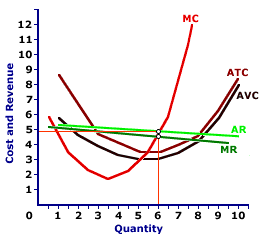A monopolistically competitive firm guided by the pursuit of profit is inclined to produce no output if the quantity that equates marginal revenue and marginal cost in the short run incurs an economic loss greater than total fixed cost. The key to this shutdown production decision is a comparison of the loss incurred from producing with the loss incurred from not producing. If price is less than average variable cost, then the firm incurs a smaller loss by not producing than by producing.One of Three Alternatives
| Production Alternatives | | Price and Cost | Result |
|---|
| P > ATC | Profit Maximization |
| ATC > P > AVC | Loss Minimization |
| P < AVC | Shutdown |
Shutting down is one of three short-run production alternatives facing a monopolistically competitive firm. All three are displayed in the table to the right. The other two are profit maximization and loss minimization.- With profit maximization, price exceeds average total cost at the quantity that equates marginal revenue and marginal cost. In this case, the firm generates an economic profit.
- With loss minimization, price exceeds average variable cost but is less than average total cost at the quantity that equates marginal revenue and marginal cost. In this case, the firm incurs a smaller loss by producing some output than by producing no output.
Deluxe Club Sandwich Production
The marginal approach to analyzing a monopolistically competitive firm's short-run production decision can be used to identify the shutdown alternative. The exhibit displayed here illustrates the short-run production decision by Manny Mustard's House of Sandwich, a hypothetical monopolistically competitive firm that specializes in the production of Deluxe Club Sandwiches, a tasty luncheon meal enjoyed by Shady Valley residents.| Profit and Loss |  |
The three U-shaped cost curves used in this analysis provide all of the information needed on the cost side of the Manny's decision. The demand curve facing the firm (which is also the firm's average revenue curve) and the corresponding marginal revenue curve provide all of the information needed on the revenue side.For the time being, Manny maximizes profit by producing 6 sandwiches and charging a price of $4.95. This profit-maximizing situation depends on the existing demand conditions. Should this demand change, then maximizing a positive profit is not the primary concern of Manny. His decision turns to minimizing loss. Click the [Less Demand] button to illustrate the situation facing Manny with a decrease in demand.
As the demand shifts leftward, the marginal revenue curve also shifts leftward. The new profit-maximizing intersection between marginal cost and marginal revenue is at 4 sandwiches. The price Manny charges for this quantity of production is then $2.25.
The key is that this new, lower price is below the average variable cost curve. This means that Manny does not generate enough revenue per sandwich sold (average revenue = $2.25) to cover the cost of producing each sandwich (average total cost = $4.05).
Manny clearly incurs an economic loss on each sandwich produced and sold. In fact, if Manny produces 4 sandwiches, then his total cost is $16.20, but his total revenue is only $9. He incurs an economic loss of $7.20, a loss of $1.80 per sandwich produced.
The Short-Run Choice
Perhaps Manny should stop producing. Perhaps he is better off by NOT selling sandwiches. Unfortunately, Manny is faced with short-run fixed cost. Manny incurs a total fixed cost of $3 whether or not he engages in any short-run production. Even if he shuts down production, he still must pay this $3 of fixed cost.As such, Manny is faced with a comparison between the loss incurred from producing with the loss incurred from not producing. Those are his two short-run choices. If he produces, he incurs a loss of $7.20. If he does not produce, he incurs a loss of $3.
The choice seems relatively obvious: Manny is better off not producing any sandwiches, incurring an economic loss of $3, and hoping for an increase in the demand. Should he produce any sandwiches, he incurs a greater loss than just paying total fixed cost.
Manny does not produce in the short run because he does not generate enough revenue to pay his variable cost, let alone any part of fixed cost. By producing 2 sandwiches, he generates $9 of total revenue. This revenue not only falls short of covering the $16.20 of total cost, neither is it enough to pay the $13.20 of total variable cost. This is why the economic loss from production is greater than total fixed cost.
Even though Manny has some market control, he is still subject to the whims of the demand-side of the market. This $2.25 sandwich price does not generate sufficient total revenue for Manny to pay ALL variable cost, let alone fixed cost. However, should demand change, then Manny would have to reevaluate his production decision. If the demand increases enough, Manny is be able to produce sandwiches in the short run.
MONOPOLISTIC COMPETITION, SHUTDOWN, AmosWEB Encyclonomic WEB*pedia, http://www.AmosWEB.com, AmosWEB LLC, 2000-2024. [Accessed: July 26, 2024].


